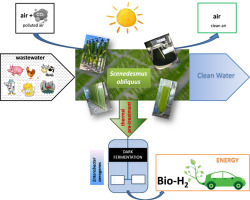Environmental Research ( IF 7.7 ) Pub Date : 2018-02-22 , DOI: 10.1016/j.envres.2018.02.007 Alice Ferreira , Paula Marques , Belina Ribeiro , Paula Assemany , Henrique Vieira de Mendonça , Ana Barata , Ana Cristina Oliveira , Alberto Reis , Helena M. Pinheiro , Luisa Gouveia

|
The ability of microalgae to grow in nutrient-rich environments and to accumulate nutrients from wastewaters (WW) makes them attractive for the sustainable and low-cost treatment of WW. The valuable biomass produced can be further used for the generation of bioenergy, animal feed, fertilizers, and biopolymers, among others. In this study, Scenedesmus obliquus was able to remove nutrients from different wastewaters (poultry, swine and cattle breeding, brewery and dairy industries, and urban) with removal ranges of 95–100% for nitrogen, 63–99% for phosphorus and 48–70% for chemical oxygen demand. The biomass productivity using wastewaters was higher (except for poultry) than in synthetic medium (Bristol), the highest value being obtained in brewery wastewater (1025 mg/(L.day) of freeze-dried biomass). The produced biomass contained 31–53% of proteins, 12–36% of sugars and 8–23% of lipids, regardless of the type of wastewater.
The potential of the produced Scenedesmus obliquus biomass for the generation of BioH2 through batch dark fermentation processes with Enterobacter aerogenes was evaluated. The obtained yields ranged, in mL H2/g Volatile Solids (VS), from 50.1 for biomass from anaerobically digested cattle WW to 390 for swine WW, whereas the yield with biomass cultivated in Bristol medium was 57.6 mL H2/gVS.
中文翻译:

将生物技术与循环生物经济相结合:从家禽,猪,牛,啤酒厂,乳制品和城市废水到生物氢
微藻在营养丰富的环境中生长以及从废水(WW)中积累养分的能力使它们对于WW的可持续和低成本处理具有吸引力。产生的有价值的生物质可进一步用于生物能源,动物饲料,肥料和生物聚合物等的生产。在这项研究中,斜叶景天能够从不同的废水(家禽,猪和牛的繁殖,啤酒和乳制品业以及城市)中去除营养,氮的去除率范围为95-100%,磷的去除率范围为63-99%,化学需氧量的去除范围为48-70% 。使用废水的生物量生产率(家禽除外)比合成培养基(布里斯托尔)要高,其中啤酒废水(1025 mg /(L.day)的冻干生物量)获得了最高的价值。无论废水的类型如何,产生的生物质均包含31–53%的蛋白质,12–36%的糖和8–23%的脂质。
评估了产生的斜生海藻生物质通过产气肠杆菌分批黑暗发酵过程产生BioH 2的潜力。将所得到的产率范围,在毫升水2 /克挥发性固体(VS),从50.1用于从厌氧消化的牛WW生物质以390为猪WW,而用生物质在布里斯托尔培养基中培养的产率是57.6毫升水2 / g的VS。











































 京公网安备 11010802027423号
京公网安备 11010802027423号